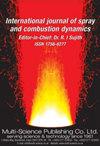Effect of geometrical parameters and use of porous material in a Helmholtz resonator on suppression of thermo-acoustic instabilities
IF 2.1
4区 工程技术
Q3 ENGINEERING, MECHANICAL
International Journal of Spray and Combustion Dynamics
Pub Date : 2023-03-06
DOI:10.1177/17568277231158900
引用次数: 0
Abstract
Thermo-acoustic instabilities are mainly formed due to in-phase superposition of non-uniform heat release and pressure variation in the combustors of gas turbines, rocket engines and other acoustically confined spaces. These instabilities not only damage the structural system but also reduce its combustion efficiency and heat transfer rate. Hence suppression of thermo-acoustic instabilities is a prominent requirement for stable and safe heat generation in the combustors. In this work, the Helmholtz resonator has been used to suppress the instability. The efficacy of the resonator has been further increased by the addition of absorptive material to it. This work concentrates on inspecting the influence of cavity volume, neck length and neck diameter of the Helmholtz Resonator and the thickness of the absorptive material in the damping process of thermo-acoustic instabilities. The experimentation was carried out for various combinations of resonator cavity volume, neck diameter and neck length, and the best combination was found to be 6 mm neck diameter with 20 mm neck length at 60% volume which provided an acoustic damping of around 30 dB. Further, it was noticed that the addition of absorptive material is effective at lower volumes of Helmholtz resonator, and with an increase in thickness of absorptive material beyond a certain limit, the damping ability of the resonator reduces.几何参数和多孔材料在亥姆霍兹谐振器中的应用对抑制热声不稳定性的影响
热声不稳定性主要是由于燃气轮机、火箭发动机和其他声学密闭空间的燃烧室中不均匀放热和压力变化的相叠加而形成的。这些不稳定性不仅会破坏结构系统,而且会降低其燃烧效率和传热速率。因此,抑制热声不稳定性是燃烧室稳定、安全产热的重要要求。在这项工作中,亥姆霍兹谐振器被用来抑制不稳定性。在谐振腔中加入吸波材料,进一步提高了谐振腔的效能。本文主要研究了腔体体积、颈长、颈直径以及吸收材料厚度对热声不稳定性阻尼过程的影响。对谐振腔体积、颈径和颈长进行了不同的组合实验,发现在60%的体积下,颈径为6 mm、颈长为20 mm的最佳组合可以提供30 dB左右的声阻尼。进一步发现,吸收材料的加入在较小体积的亥姆霍兹谐振腔中是有效的,并且随着吸收材料厚度的增加超过一定限度,谐振腔的阻尼能力降低。
本文章由计算机程序翻译,如有差异,请以英文原文为准。
求助全文
约1分钟内获得全文
求助全文
来源期刊

International Journal of Spray and Combustion Dynamics
THERMODYNAMICS-ENGINEERING, MECHANICAL
CiteScore
2.20
自引率
12.50%
发文量
21
审稿时长
>12 weeks
期刊介绍:
International Journal of Spray and Combustion Dynamics is a peer-reviewed open access journal on fundamental and applied research in combustion and spray dynamics. Fundamental topics include advances in understanding unsteady combustion, combustion instability and noise, flame-acoustic interaction and its active and passive control, duct acoustics...
 求助内容:
求助内容: 应助结果提醒方式:
应助结果提醒方式:


